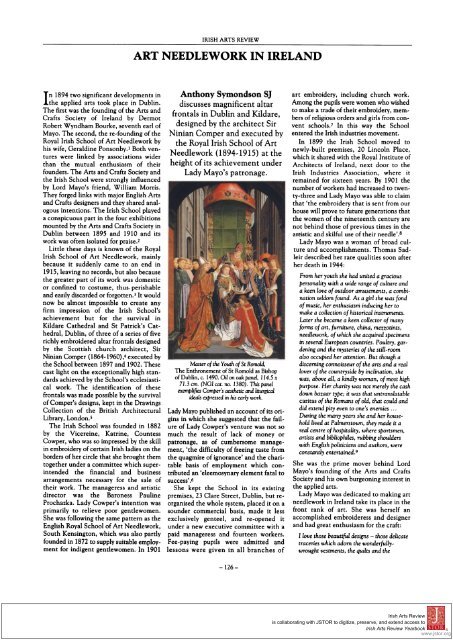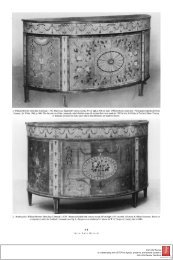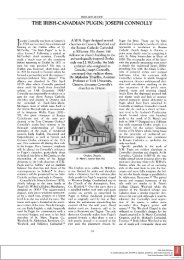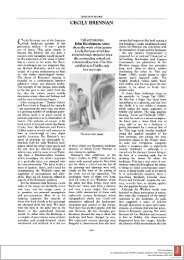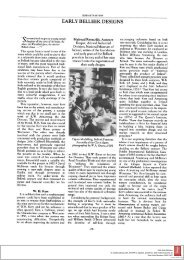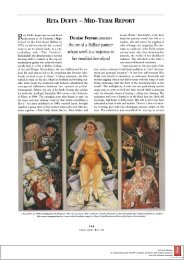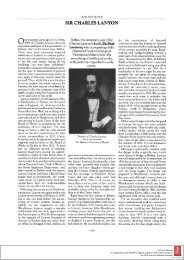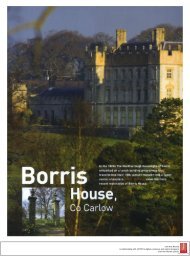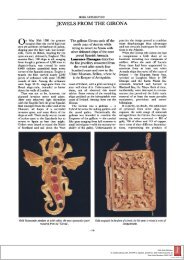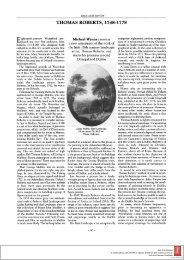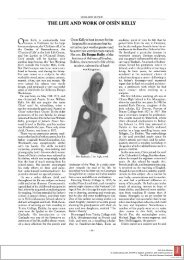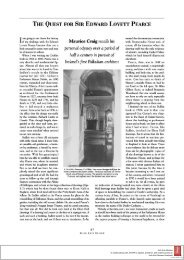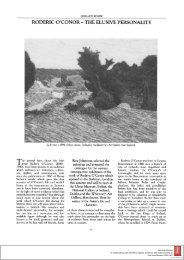ART NEEDLEWORK IN IRELAND - Irish Arts Review
ART NEEDLEWORK IN IRELAND - Irish Arts Review
ART NEEDLEWORK IN IRELAND - Irish Arts Review
You also want an ePaper? Increase the reach of your titles
YUMPU automatically turns print PDFs into web optimized ePapers that Google loves.
In 1894 two significant developments in<br />
the applied arts took place in Dublin.<br />
The first was the founding of the <strong>Arts</strong> and<br />
Crafts Society of Ireland by Dermot<br />
Robert Wyndham Bourke, seventh earl of<br />
Mayo. The second, the re-founding of the<br />
Royal <strong>Irish</strong> School of Art Needlework by<br />
his wife, Geraldine Ponsonby.' Both ven<br />
tures were linked by associations wider<br />
than the mutual enthusiasm of their<br />
founders. The <strong>Arts</strong> and Crafts Society and<br />
the <strong>Irish</strong> School were strongly influenced<br />
by Lord Mayo's friend, William Morris.<br />
They forged links with major English <strong>Arts</strong><br />
and Crafts designers and they shared anal<br />
ogous intentions. The <strong>Irish</strong> School played<br />
a conspicuous part in the four exhibitions<br />
mounted by the <strong>Arts</strong> and Crafts Society in<br />
Dublin between 1895 and 1910 and its<br />
work was often isolated for praise.2<br />
Little these days is known of the Royal<br />
<strong>Irish</strong> School of Art Needlework, mainly<br />
because it suddenly came to an end in<br />
1915, leaving no records, but also because<br />
the greater part of its work was domestic<br />
IRISH <strong>ART</strong>S REVIEW<br />
<strong>ART</strong> <strong>NEEDLEWORK</strong> <strong>IN</strong> <strong>IRELAND</strong><br />
Anthony Symondson SJ<br />
discusses magnificent altar<br />
frontals in Dublin and Kildare,<br />
designed by the architect Sir<br />
Ninian Comper and executed by<br />
the Royal <strong>Irish</strong> School of Art<br />
Needlework (1894-1915) at the<br />
height of its achievement under<br />
Lady Mayo's patronage.<br />
or confined to costume, thus. perishable<br />
and easily discarded or forgotten.3 It would<br />
now be almost impossible to create any<br />
firm impression of the <strong>Irish</strong> School's<br />
achievement but for the survival in<br />
Kildare Cathedral and St Patrick's Cat<br />
hedral, Dublin, of three of a series of five<br />
richly embroidered altar frontals designed<br />
by the Scottish church architect, Sir<br />
Ninian Comper (1864-1960),4 executed by<br />
the School between 1897 and 1902. These<br />
Master of the Youth of St Romold,<br />
cast light on the exceptionally high stan<br />
dards achieved by the School's ecclesiasti<br />
cal work. The identification of these<br />
frontals was made possible by the survival<br />
of Comper's designs, kept in the Drawings<br />
The Enthronement of St Romold as Bishop<br />
of Dublin, c. 1490. Oil on oak panel, 114.5 x<br />
71.3 cm. (NGI cat. no. 1380). This panel<br />
exemplifies Comper's aesthetic and liturgical<br />
ideals expressed in his early work.<br />
Collection of the British Architectural<br />
Library, London.5<br />
Lady Mayo published an account of its ori<br />
gins in which she suggested that the fail<br />
The <strong>Irish</strong> School was founded in 1882 ure of Lady Cowper's venture was not so<br />
by the Vicereine, Katrine, Countess much the result of lack of money or<br />
Cowper, who was so impressed by the skill patronage, as of cumbersome manage<br />
in embroidery of certain <strong>Irish</strong> ladies on the ment, 'the difficulty of freeing taste from<br />
borders of her circle that she brought them the quagmire of ignorance' and the chari<br />
together under a committee which super table basis of employment which con<br />
intended the financial and business tributed an 'eleemosynary element fatal to<br />
arrangements necessary for the sale of success'.6<br />
their work. The manageress and artistic<br />
director was the Baroness Pauline<br />
Prochazka. Lady Cowper's intention was<br />
primarily to relieve poor gentlewomen.<br />
She kept the School in its existing<br />
premises, 23 Clare Street, Dublin, but re<br />
organised the whole system, placed it on a<br />
sounder commercial basis, made it less<br />
She was following the same pattern as the<br />
English Royal School of Art Needlework,<br />
exclusively genteel, and re-opened it<br />
under a new executive committee with a<br />
South Kensington, which was also partly paid manageress and fourteen workers.<br />
founded in 1872 to supply suitable employ<br />
ment for indigent gentlewomen. In 1901<br />
Fee-paying pupils were admitted and<br />
lessons were given in all branches of<br />
-126 -<br />
art embroidery, including church work.<br />
Among the pupils were women who wished<br />
to make a trade of their embroidery, mem<br />
bers of religious orders and girls from con<br />
vent schools.7 In this way the School<br />
entered the <strong>Irish</strong> industries movement.<br />
In 1899 the <strong>Irish</strong> School moved to<br />
newly-built premises, 20 Lincoln Place,<br />
which it shared with the Royal Institute of<br />
Architects of Ireland, next door to the<br />
<strong>Irish</strong> Industries Association, where it<br />
remained for sixteen years. By 1901 the<br />
number of workers had increased to twen<br />
ty-three and Lady Mayo was able to claim<br />
that 'the embroidery that is sent from our<br />
house will prove to future generations that<br />
the women of the nineteenth century are<br />
not behind those of previous times in the<br />
artistic and skilful use of their needle'.8<br />
Lady Mayo was a woman of broad cul<br />
ture and accomplishments. Thomas Sad<br />
leir described her rare qualities soon after<br />
her death in 1944:<br />
From her youth she had united a gracious<br />
personality with a wide range of culture and<br />
a keen love of outdoor amusements, a combi<br />
nation seldom found. As a girl she was fond<br />
of music, her enthusiasm inducing her to<br />
make a collection of historical instruments.<br />
Later she became a keen collector of many<br />
forms of art, furniture, china, mezzotints,<br />
needlework, of which she acquired specimens<br />
in several European countries. Poultry, gar<br />
dening and the mysteries of the still-room<br />
also occupied her attention. But though a<br />
discerning connoisseur of the arts and a real<br />
lover of the countryside by inclination, she<br />
was, above all, a kindly woman, of most high<br />
purpose. Her charity was not merely the cash<br />
down bazaar type; it was that untranslatable<br />
caritas of the Romans of old, that could and<br />
did extend pity even to one's enemies ...<br />
During the many years she and her house<br />
hold lived at Palmerstown, they made it a<br />
real centre of hospitality, where sportsmen,<br />
artists and bibliophiles, rubbing shoulders<br />
with English politicians and authors, were<br />
constantly entertained.9<br />
She was the prime mover behind Lord<br />
Mayo's founding of the <strong>Arts</strong> and Crafts<br />
Society and his own burgeoning interest in<br />
the applied arts.<br />
Lady Mayo was dedicated to making art<br />
needlework in Ireland take its place in the<br />
front rank of art. She was herself an<br />
accomplished embroideress and designer<br />
and had great enthusiasm for the craft:<br />
I love those beautiful designs - those delicate<br />
traceries which adorn the wonderfully<br />
wrought vestments, the quilts and the<br />
<strong>Irish</strong> <strong>Arts</strong> <strong>Review</strong><br />
is collaborating with JSTOR to digitize, preserve, and extend access to<br />
<strong>Irish</strong> <strong>Arts</strong> <strong>Review</strong> Yearbook ®<br />
www.jstor.org
w~~ ~~~~~ ~ ~ ~~ ~~~~~~~~~~~~~~~~~~~~~~~~~~~~~~~~<br />
'<br />
4~~~~14<br />
4o<br />
! ~~~~~~~~'; ' 4 ~ t v c0-:<br />
_<br />
I *K1 ,, ? .- i I \ ; 0 -<br />
tjxi~ ~~~SIA 1 1. 1 ,il S 1 i,l;l "1idl&11i ;,f:3 5;<br />
4vt'<br />
1'<br />
' 2N.<br />
x ~~~~~~~~~~~~~~~~K<br />
E~~~~~~~~~~~~~~~~~~~~~~~~~~~~~~~~~~~~~~W<br />
X , '42 -., . .> -+ r.SD~e, -AD '' '<br />
_ < , _N7<br />
''~~~~~~~~~~~~~~~~~~~~~~~~~~~~.7<br />
E<br />
~ ~ i~ S . t' '<<br />
>~ ~ ~ ~ ~ ~~~1 r7><br />
Lkt C<br />
v~~~~~'b~ diA Ct _KYJ' '$-4p4<br />
_ ~ ~ .N<br />
- ''<br />
'<br />
'A<br />
'<br />
)I'l ~ ~ '4<br />
zlt
screens, to execute which (with marvellous<br />
and complicated stitches introduced) formed<br />
the principal occupation of the lady of olden<br />
times. Her frame was her close and intimate<br />
companion, and these elaborate art pieces<br />
filled the long hours of solitude imposed upon<br />
her by her household tyrant. Who can say<br />
whether she was a whit less happy than we in<br />
our advanced freedom?1I<br />
In the first exhibition of the <strong>Arts</strong> and<br />
Crafts Society, in 1895, Lady Mayo<br />
showed an embroidered linen cushion<br />
cover, adapted from a drawing by the<br />
English church architect, John Dando<br />
Sedding, which was praised for the decora<br />
tive effect it achieved by simple means.<br />
In 1897 Alan Cole, the Official Exam<br />
iner in Art, of the Department of Science<br />
and Art, South Kensington, visited <strong>Irish</strong><br />
lace-making and embroidery schools in<br />
order to help them raise their standards of<br />
design. He included the <strong>Irish</strong> School and<br />
made a distinction between it and other<br />
schools he had visited:<br />
IRISH <strong>ART</strong>S REVIEW<br />
<strong>ART</strong> <strong>NEEDLEWORK</strong> <strong>IN</strong> <strong>IRELAND</strong><br />
during the first half of the twentieth cen<br />
tury. At this time he was lodging with<br />
Father George Hollings SSJE, a Cowley<br />
Father who was chaplain of the Society of<br />
the Sisters of Bethany, an Anglican reli<br />
gious order, in Lloyd Street, Clerkenwell.15<br />
Like many Anglican convents, the order<br />
had an embroidery room, but not then one<br />
of noticeable distinction. In 1886 Comper,<br />
at the age of twenty-two, had been invited<br />
to design a mitre for their sacristy.'6 Soon<br />
after, the School of Embroidery of the<br />
Sisters of Bethany was founded under<br />
Comper's direction. Its object was 'to fol<br />
low as closely as possible upon the lines of<br />
the old English work in its best days'.<br />
These were understood to have been the<br />
fourteenth and fifteenth centuries.17<br />
Detail of St Patrick, central panel,<br />
frontal for<br />
I should perhaps say that the Institution is<br />
hardly a school in the stricter sense of the<br />
word: the greater amount of work is done by<br />
ladies, who are glad of the occupation and of<br />
its remuneration; when called upon, the<br />
school provides instruction to beginners and<br />
learners.<br />
There he met Lady Mayo and Miss Harriet<br />
Beresford, the Manageress. Cole discussed<br />
some of the revisions he thought might be<br />
adopted in the ornamentation of the<br />
embroideries with Miss Beresford and Mrs<br />
Swan, the School's designer and draughts<br />
woman, who was also employed to look<br />
after patterns and signs. When he was<br />
shown specimens of the different kinds of<br />
embroidery that were being done he<br />
noticed their similarity to the work of the<br />
Royal School of Art Needlework, South<br />
Kensington. Later, at Palmerstown, he<br />
showed Lady Mayo photographs of work<br />
which he thought would provide better<br />
exemplars. In his report Cole wrote, 'Lady<br />
Mayo was much interested in them and<br />
thought important suggestions could be<br />
derived from them fot the improvement of<br />
embroideries done at her school'.1I<br />
Lady Mayo's major innovation was in<br />
the design of the work produced by the<br />
<strong>Irish</strong> School. Baroness Prochazka was<br />
described by Mrs Ernest Hart as having 'a<br />
happy genius for designing' but from<br />
descriptions of her work it was heavily<br />
dependent upon copying old patterns. For<br />
artistic direction Lady Mayo turned to<br />
England. She was in correspondence with<br />
the In this way Comper moved from the<br />
influences of the Aesthetic Movement<br />
high altar, St Patrick's Cathdral,<br />
Dublin, 1899-1900.<br />
which he had imbibed from Bodley. He<br />
declined to follow the free expression of<br />
the <strong>Arts</strong> and Crafts but established an<br />
some of the 'best designers of the day'.12<br />
independent line of his own, basing his<br />
work on late-medieval precedent. The<br />
The catalogues of the exhibitions of the Bethany School came to produce the<br />
<strong>Arts</strong> and Crafts Society are instructive in finest church embroidery in the British<br />
identifying some of them. They included Isles, higher than the standards of other<br />
Walter Crane and Kate Greenawayl3 Anglican convent embroidery rooms. In<br />
(both of whom designed book-covers); time the school achieved work of match<br />
work was made up from designs supplied less quality which was the most accom<br />
by Morris & Co. A surprising choice was plished at that time to be found in<br />
the Revd Ernest Geldart, an English cleri Northern Europe.<br />
cal architect who had been a pupil of In 1896 Comper completed the chapel<br />
Alfred Waterhouse and who was the of St Sepulchre in the crypt of St Mary<br />
author of The Art of Garnishing Churches Magdalene's, Paddington. Comper's design<br />
(1882) and the Manual of Church was inspired by English medieval minia<br />
Decoration and Symbolism (1899). Geldart's tures and Flemish panel paintings. It is a<br />
work was influenced more by the Aes living fusion of both influences. It was<br />
thetic Movement of the 1880s than the directly influenced by the fifteenth-centu<br />
new directions initiated by the <strong>Arts</strong> and ry chapel of St Mary Undercroft in<br />
Crafts Movement. John Ninian Comper's Canterbury Cathedral. But as an expres<br />
association with the <strong>Irish</strong> School was sion of the late-medieval Gothic of<br />
established early in Lady Mayo's reforma Northern Europe, in which Flemish min<br />
tion and was occasioned by a commission gled with English influences, it demon<br />
for an altar frontal for Kildare Cathedral. strated Comper's magical power of resur<br />
It should not, however, be thought that recting Gothic. The chapel and its furni<br />
the <strong>Irish</strong> School was exclusively bound to ture made a powerful impact upon ecclesi<br />
England. Celtic design, inspired by the astical taste.18<br />
Book of Kells, was sometimes applied, Integral to the chapel's iconography is<br />
especially in some of the magnificent an altar frontal of yellow velvet embroi<br />
embroidered dresses which became a prin dered with two tiers of seraphim divided<br />
cipal feature of the School's work.14 into five panels by thin orphreys of gold<br />
Comper was a pupil of the church archi embroidered with the monogram of St<br />
tect, George Frederick Bodley. In 1888 he Mary Magdalene.<br />
had established an ecclesiastical practice In 1897 Comper met Mrs Percy<br />
in partnership with William Bucknall, a Wyndham when she was brought to see<br />
pupil of the architect Edward Robert the chapel by Father Philip Waggett<br />
Robson. Comper became the most influen SSJE.T9 Madeline Wyndham is today best<br />
tial church architect practising in England known for being the chateleine of Clouds,<br />
- 128 -
IRISH <strong>ART</strong>S REVIEW<br />
<strong>ART</strong> <strong>NEEDLEWORK</strong> <strong>IN</strong> <strong>IRELAND</strong><br />
a country house at East Knoyle in of Art Needlework, South Kensington. gregation of St Cyprian's, Clarence Gate,<br />
Wiltshire, designed by Philip Webb. She Her experience had been sought by her from its completion in 1903; it was<br />
was the mother of George Wyndham20 the friend Geraldine Mayo in her own revival Comper's early masterpiece. Lady Mayo<br />
politician; her three daughters were dra of the <strong>Irish</strong> School in Dublin. Mrs regarded it as the most beautiful church in<br />
matically painted by John Singer Sargent. Wyndham tried to persuade Comper to London.24<br />
Her children were members of an exclu become the South Kensington School's Kildare Cathedral was re-opened in<br />
sive aristocratic group known as the Souls, artistic director but he declined. When 1896 by the Archbishop of Canterbury,<br />
all of whom were in polite revolt against Lady Mayo sought advice on a suitable Edward White Benson, after a long and<br />
the Victorianism of the older generation. designer for an altar frontal she recom surprisingly restrained restoration by GE<br />
Mrs Wyndham was also a London hostess mended Comper without reserve.22 Street. Its rescue, after lying roofless for<br />
with a house at 44 Belgrave Square. An From the moment of their introduction three hundred years, was greeted with<br />
admirer of the Pre-Raphaelites, she was a by Mrs Wyndham, Lady Mayo and enthusiasm by the ecclesiastically-minded<br />
friend and patron of William Morris and Comper established an instinctive sympa members of the Church of Ireland in Co<br />
Sir Edward Burne-Jones and was painted thy. They were contemporaries and Kildare. There was, for example, Mrs<br />
by George Frederick Watts. An enamellist, remained friends for the rest of her life.23 Wakefield of Carnalway Lodge. Since her<br />
she was a pupil and patron of Alexander Quite apart from their interest in church widowhood in 1888 she had given her<br />
Fisher, an <strong>Arts</strong> and Crafts silversmith and embroidery and the applied arts, they energies and fortune to relieving the local<br />
enamellist, whose work she actively shared the same religious convictions. Catholic poor, to whom she was devoted,<br />
encouraged.21<br />
Anglo-Catholicism was the guiding spiri and re-building St Patrick's, Carnalway, in<br />
What most impressed her in St tual force in Lord and Lady Mayo's English the Hiberno-Romanesque style under the<br />
Sepulchre's chapel was the altar frontal. circle. Many of the Mayos' friends became direction of James Franklin Fuller.25 She<br />
At the time she met Comper, she had long Comper's patrons. When they were in offered the Dean an altar frontal and<br />
been closely involved in the Royal School London they both formed part of the con turned to the <strong>Irish</strong> School for its execution.<br />
Chapel of St Sepulchre, St Mary Magdalene, Paddington, London, 1895-96. St Cyprian, Clarence Gate, London, 1902-03. Lady Mayo<br />
The altar frontal led to Lady Mayo's introduction to Comper considered it to be the most beautiful church in London and was a member of<br />
by Mrs Percy Wyndham. the congregation. The rose briar patterns on the altar hangings are similar to<br />
those first designed by Comper for the frontal at Windsor Castle.<br />
- 129
Lady Mayo found it difficult to fulfil her<br />
Anglo-Catholic convictions in the puri<br />
tanical bareness and coldness of the<br />
Church of Ireland. The opportunity of<br />
providing an altar frontal for Kildare<br />
Cathedral designed by such an artist as<br />
Comper was eagerly seized. Not only<br />
would it enhance the reputation and stan<br />
dard of the <strong>Irish</strong> School but, indirectly,<br />
would contribute to a better standard of<br />
churchmanship.<br />
Comper did not like to design windows,<br />
furniture or embroidery for churches with<br />
out knowing who was the patron saint and<br />
the date of the building. He wanted to<br />
establish his work in local tradition and<br />
make it an integral part of its architectural<br />
context.26 At Kildare, pictorial icono<br />
graphy was forbidden under a severe appli<br />
cation of the Church of Ireland's canons;<br />
but the legend of St Brigid inspired the<br />
frontal's symbolism.<br />
Elaborately embroidered in alternate<br />
panels of cloth of gold and crimson silk<br />
damask, a row of vesica-shaped branches,<br />
executed in metallic braid with leaves of<br />
gold thread, contain alternate centres rep<br />
resenting pineapples in couched gold<br />
IRISH <strong>ART</strong>S REVIEW<br />
<strong>ART</strong> <strong>NEEDLEWORK</strong> <strong>IN</strong> <strong>IRELAND</strong><br />
Geraldine, Countess of Mayo (1863-1944),<br />
portrait miniature showing her at her embroidery<br />
frame. Private Collection.<br />
tion of these elements is conceived in late<br />
medieval terms but in a way entirely per<br />
sonal to Comper himself.<br />
For the <strong>Irish</strong> School, the Kildare frontal<br />
represented a tour de force, demonstrating<br />
the standards it had begun to achieve<br />
under Comper's influence. When it was<br />
finished Lady Mayo declared: 'I think I<br />
may say, without fear of contradiction,<br />
that it is about as good a specimen of<br />
artistic needlework as the present day can<br />
produce'.27<br />
Mrs Wakefield was equally pleased. She<br />
commissioned Comper in 1898 to design<br />
the east window of Carnalway church. It is<br />
altar and lady chapel. Most were executed<br />
by the embroidery school of the Anglican<br />
community of St Mary the Virgin,<br />
Wantage. Miss Jellett died in 1898, and for<br />
the continuation of the scheme the Dean<br />
turned to Lady Mayo.30 Internal tradition<br />
suggests that Lady Mayo's involvement<br />
might have been controversial; there are<br />
no references to the frontals commissioned<br />
by Dean Jellett in the cathedral muni<br />
ments, nor are they referred to in the <strong>Irish</strong><br />
Ecclesiastical Gazette.<br />
The frontal for the high altar was<br />
designed as a national statement. A figure<br />
of St Patrick occupies the centre of seven<br />
panels on a softly-patterned ground of<br />
crimson silk. He is represented vested,<br />
croziered and mitred, in the act of bless<br />
ing, standing on a green shamrock-pow<br />
dered sward. The figure is executed in gold<br />
and green silk applique, embroidered in<br />
couched gold thread and white floss, with<br />
small jewels in the crocketted mitre. The<br />
six flanking panels are embroidered with<br />
conventionalised sprigs of shamrock and<br />
gold daisies divided by six orphreys of yel<br />
low green silk, embroidered in gold couch<br />
ed work with the monogram IHS alternat<br />
thread, alive with St Brigid's eternal flame,<br />
ing with St Patrick's own monogram, uni<br />
executed in rose-red and pink floss; and<br />
fied by borders of white crown imperial<br />
lilies in green and white floss, heavily out<br />
lilies and roses in white and rose floss silk.<br />
lined, standing in vases of couched gold<br />
It has a crimson super-frontal inscribed<br />
thread, symbolizing her virginity. Linking<br />
'The Holy Church throughout all the<br />
the alternating panels are crowns of silver<br />
world doth acknowledge Thee', (from the<br />
thread, symbolizing her heavenly reward.<br />
Te Deum), in black-letter, executed in<br />
The spandrels formed by the points of the<br />
green, black and gold thread, divided by<br />
vesicas are embroidered with formalised<br />
small sprigs of shamrock. The frontal is a<br />
pomegranates, in silk floss, completed by a<br />
work of delicacy and refinement, demon<br />
fringe of parti-coloured silk in two shades<br />
of green. The super-frontal is worked with<br />
a row of six fleurs de-lys in gold basket<br />
a striking window, representing an idealis<br />
tic depiction of The Transfiguration. The<br />
<strong>Irish</strong> Ecclesiastical Gazette praised it, des<br />
strating the finish, faultless and exquisite,<br />
achieved by the <strong>Irish</strong> School at what had<br />
become the best period of its life.<br />
stitch on a crimson ground, with the cribing it as 'not only beautiful but elevat In 1900 Queen Victoria made her last<br />
Alpha and Omega enclosed in plaited cir ing, the best quality of glass, unique, state visit to Dublin. She was the<br />
cles at each extremity, and has a matching<br />
parti-coloured fringe.<br />
uncommon and luminous'; but the win<br />
dow's late-Perpendicular Gothic style and<br />
President of the <strong>Irish</strong> School and while she<br />
was in Dublin she was shown examples of<br />
Comper's design is not a replica of fif the ruby-coloured robes of the angels were the School's work which greatly impressed<br />
teenth-century work, even though it considered to be out of character with the her. She gave two commissions, of which<br />
exhibits the mentality of a Flemish panel Hiberno-Romanesque character of the the first was for an altar frontal for the<br />
painter. It is a fusion of his own personal church.28 Later still, in 1902, Mrs lady chapel of St Patrick's. Comper was<br />
elements, precedent and naturalism. For Wakefield commissioned a small gilded chosen as the designer for both of them.<br />
instance, the vases of lilies are taken from reredos, representing Christ at Emmaus.29 The lady chapel frontal is simpler than the<br />
the outer panels of the Annunciation in<br />
van Eyck's painting of The Adoration of the<br />
The success of the Kildare frontal led to<br />
further commissions. The national cathe<br />
frontal for the high altar. The design is<br />
composed of an overall pattern of cusped<br />
Mystic Lamb, in Ghent, translated into dral of St Patrick, Dublin, was an obvious and linked vesicas in gold thread, unified<br />
embroidery. The flowers and fruit are setting for the work of the <strong>Irish</strong> School. by formalised powderings of dog roses in<br />
directly modelled from nature. Although Lady Mayo had, however, been anticipat white floss and fleurs-de-lys in cloth-of<br />
they make a formalised pattern, they ed in 1891 by the Dean's daughter, Miss<br />
retain their freshness and were executed Minna Jellett, who had initiated an ambi<br />
to look as though they had been newly laid tious scheme for a sequence of heavily<br />
on the surface of the frontal. The disposi embroidered altar frontals for the high<br />
gold applique on a rose-red ground. It has<br />
a plain super-frontal of cloth of gold with a<br />
fringe of yellow green. There is a distinc<br />
tion in the colour of the frontal, rose-red<br />
- 130 -
ather than the crimson of the frontal for<br />
the high altar. The adoption of this tone<br />
had serious implications for the future of<br />
Comper's work, of sufficient significance<br />
to justify a digression.<br />
Purity of colour was an essential element<br />
of Comper's aesthetic quest. It was for this<br />
reason that, in 1893, he had begun to<br />
design his own ecclesiastical textiles which<br />
were woven by a long established firm of<br />
Spitalfields silk weavers, M Perkins & Son,<br />
of 25-27 Curtain Road, Shoreditch.31<br />
Under the influence of Bodley, the fashion<br />
had set in in church work for muted half<br />
tones, olive green, brownish or scarlet<br />
reds.32 Comper saw that they were not true<br />
to the colours he had seen in medieval<br />
textiles and embroidery, nor to the lumi<br />
nous purity of colour found in Flemish<br />
panel paintings and illuminated manu<br />
scripts. His early attempts to achieve the<br />
old traditional red are found in the Kildare<br />
frontal and the frontal for the high altar of<br />
St Patrick's. What he sought even more<br />
ardently was the pure rose colour seen, not<br />
IRISH <strong>ART</strong>S REVIEW<br />
<strong>ART</strong> <strong>NEEDLEWORK</strong> <strong>IN</strong> <strong>IRELAND</strong><br />
Sir Ninian Comper (1864-1960).<br />
mindedly medieval, in which St Patrick<br />
was represented with such meticulous<br />
pontifical fidelity. Dean Jellett appeared to<br />
have given Lady Mayo and Comper a free<br />
hand. The occasional use, until recently,<br />
of these frontals has led to their immacul<br />
ate condition, as fresh as the day they were<br />
made.37<br />
Comper only once visited Ireland,<br />
spending two days, 14 and 15 May 1902,<br />
in connection with his work for the <strong>Irish</strong><br />
School and for Mrs Wakefield at Carnal<br />
way, staying a night there and meeting<br />
Lady Mayo in Dublin next day. He loved<br />
it. In a letter to his mother, written in pen<br />
cil on board the Anglia leaving Dublin, he<br />
tells how he took a night train from<br />
Euston to Holyhead and then the early<br />
morning mail packet to Kingstown:<br />
secured a piece of Italian rose-red silk<br />
which had been brought back from Sicily<br />
I had a long day yesterday, arriving in<br />
Dublin about 7.30 and at Carnalway at<br />
about 10.30. It was about 3am when we<br />
approached Holyhead. A wild moon with<br />
two rifts in the morning sky; then a red light<br />
by his friend Mrs Edmund McClure.35 house and a long line of white surf; and in<br />
only in Flemish paintings,33 but surviving Wardle was able to reproduce it, and other fear I climbed up into my bed on board and<br />
in the rose-red hangings of Central and colours, with greater scientific accuracy awaited the tossing that never came! In the<br />
Southern Italian churches.<br />
than the original and also to secure its morning the sunshine was beautiful on<br />
In the early summer of 1900 Comper fastness.36 The result was first used in the<br />
had made his first visit to Rome. What altar frontal for the lady chapel of St<br />
impressed him, and influenced his evolu Patrick's.<br />
tion as an artist, were the compartments of Both altar frontals appear to have excit<br />
bright, deep-coloured blue set in the solid ed muted antagonism, despite their beauty<br />
ly gilded coffered ceilings of St John and standard of execution. The frontal for<br />
Lateran, juxtaposed with the basilica's the lady chapel, for instance, was not used<br />
rose-red hangings. They prepared the after the formation of the <strong>Irish</strong> Free State<br />
ground, and sowed the seed, of an aesthet in 1922 because the fleurs-de-lys and roses<br />
ic revision that would take Comper from -were considered to be royalist symbols.<br />
his exclusive Northern European Gothic The colour for the frontal for the high<br />
ideals to others of diverse and far-ranging altar was objected to on the ground that St<br />
influence.34<br />
Patrick was not a martyr, while the<br />
Dublin bay, and all along to Harristown, my<br />
last station, the Wicklow mountains were<br />
beautiful and blue behind a foreground of<br />
pale English green, so different from the<br />
pines at Braemar.<br />
In the afternoon I drove through the great<br />
military camp to Kildare and saw the small<br />
cathedral church, and my altar frontal (as<br />
also my altar frontal at St Patrick's today).<br />
At Carnalway I saw the glass which we<br />
painted for the east window about 2 years<br />
ago, and arranged for a reredos.<br />
My hostess, Mrs Wakefield, was full of<br />
praise of the <strong>Irish</strong> Catholics, and I am almost<br />
Fresh from Rome and under the influ absence of pentecostal symbolism made it surprised to find how much I have felt in this<br />
ence of what he had seen of Mediter unsuitable for use at Whitsun. The choice respect, as if I had crossed over to France or<br />
ranean colour, these royal commissions led<br />
to a significant development in his design<br />
of colour was made by Comper because red<br />
was the most frequently used liturgical<br />
Belgium. So far as two days in a small area<br />
can give one an impression of Ireland, I am<br />
for embroidery and evolution of colour in colour in Northern European medieval much pleased with it; what strikes me most<br />
his search for the desired rose-red in which sequences. He was antagonistic at this of all is that it seems a godly place. I have<br />
Lady Mayo played a decisive part.<br />
period of his life to the modern Roman been wandering about Dublin quite at ran<br />
She introduced him to Sir Thomas colour sequence which was followed by dom all this evening.38<br />
Wardle, of Leek, in Staffordshire, whose other frontals in St Patrick's. He believed The second commission given by Queen<br />
experiments in vegetable and oriental dye that it contravened the ornaments rubric Victoria to the <strong>Irish</strong> School was for an<br />
ing and art printing on silk, cotton and of the Book of Common Prayer which stip altar frontal of white silk for the Queen's<br />
wool had made him the foremost dyer of ulated that what had prevailed in the private chapel, Windsor Castle. Comper<br />
his time. Wardle was a friend of the Pre chancels of English churches in the second recognised that the frontal was of deter<br />
Raphaelites. He had taught William year of the reign of King Edward VI 1548 minant importance as much for the <strong>Irish</strong><br />
Morris all he knew about dyeing. Comper 49, was the standard which should apply School as for his own artistic develop<br />
told him that he wanted to use the pure to all Anglican churches and cathedrals. ment; but it gave him a great deal of<br />
traditional dyes in his experiments, dyes But quite apart from these objections I trouble. He strongly believed in the<br />
that Morris and Bodley avoided, substitut<br />
ing recipes of their own. Comper had<br />
suspect that there was an instinctive pre<br />
judice against work that was so single<br />
medieval practice of applying heraldry as<br />
ornament. A royal commission for a<br />
-131
chapel in Windsor Castle, adjacent to St<br />
George's Hall with its integral associations<br />
with medieval chivalry and the Order of<br />
the Garter, made the application of her<br />
aldry altogether suitable. Comper's design<br />
placed a figure of St George slaying the<br />
dragon in the centre between shields of<br />
Queen Victoria and the Prince Consort,<br />
both encircled by the garter, on a ground<br />
of Tudor rose briars.<br />
The Queen was approaching the end of<br />
her reign. When Comper's drawing was<br />
submitted for approval it got no further<br />
than Princess Beatrice who objected to<br />
heraldry and sent an amendment for a<br />
sacred monogram for the centre. By the<br />
time the second design was ready, the<br />
Queen was dead; but on re-submission<br />
King Edward VII accepted the original.39<br />
Writing in 1907, in an article on art<br />
embroidery in Ireland, published in<br />
association with the <strong>Irish</strong> International<br />
IRISH <strong>ART</strong>S REVIEW<br />
<strong>ART</strong> <strong>NEEDLEWORK</strong> <strong>IN</strong> <strong>IRELAND</strong><br />
Exhibition, Miss Beresford, the <strong>Irish</strong> School's<br />
manageress, writing under her married<br />
name of Mrs Domvile, isolated the<br />
Windsor frontal for description when she<br />
referred to ecclesiastical embroidery and<br />
Sir Ninian Comper, Design for centre<br />
of altar frontal for the King's private chapel,<br />
Windsor, 1901, Pencil, pen, and wash on<br />
paper, 72 x 48 cm. (Drawings Collection,<br />
British Architectural Library, RIBA, London).<br />
stated that: 'This specimen of <strong>Irish</strong> indus<br />
tries had been much admired'.40 But unac<br />
countably she wrote that the frontal was<br />
made for St George's Chapel, Windsor,<br />
whereas Comper's drawings, and his subse<br />
quent reminiscences, show that it was<br />
made for the private chapel at Windsor<br />
Castle.<br />
Regrettably, the altar frontal is no<br />
longer to be found at Windsor, nor in the<br />
Comper knew this work and read it at an<br />
impressionable period of his life.42 It would<br />
also have been known to Lady Mayo.<br />
Many of its sentiments are echoed in her<br />
own account of her enthusiasm for em<br />
broidery and her aesthetic ideals.<br />
Lady Alford isolated for praise and emu<br />
lation English late-medieval embroidery and<br />
areintne ob goiu,ad ihrrpe<br />
the embroidery and textiles of Flanders:<br />
Royal Collection, and no references to it All the most beautiful and picturesque<br />
survive in the Royal Archives. In addition needlework that we possess of the truly eccle<br />
to its value as a work of art, it is significant siastical Gothic type, and which belongs to<br />
not only in Comper's development as a the perfect flowering of the art, is of the four<br />
designer but in demonstrating how he used teenth and fifteenth centuries, just before the<br />
precedent.<br />
spirit of the Renaissance crept northward<br />
The precedent for the Tudor rose briars<br />
in the Windsor frontal came from a cope of<br />
gold tissue belonging to Stonyhurst<br />
College, Lancashire, which formed part of<br />
the vestments bequeathed by King Henry<br />
VII to Westminster Abbey in 1509. The<br />
structure of the woven design is in the form<br />
over Europe, preceding the reformnation and<br />
its iconoclastic effacements. ... The perfec<br />
tion of the embroideries of Flanders of that<br />
period has never been exceeded, and it con<br />
tinues still to produce the most splendidly<br />
executed compositions in gold and silken<br />
needlework, of every variety of stitches.43<br />
of sinuous branches of rose briars enclosing She illustrated the Stonyhurst cope,<br />
the Tudor badge and portcullises.41<br />
proposing it as a fruitful precedent;<br />
Comper did not see this cope until his<br />
first visit to Stonyhurst in 1924. In 1886,<br />
the year he had established his association<br />
with the Sisters of Bethany, Lady Marion<br />
Alford published her monumental volume,<br />
Needlework as Art, a work of immense<br />
influence upon the evolution of art em<br />
broidery, dedicated to Queen Victoria.<br />
I should advise the young ecclesiastical<br />
designer to study the principles which guided<br />
the designers of some of the finest Gothic<br />
examples which remain to use, such as the<br />
great Stonyhurst cope, and the palls of the<br />
different London companies. All these have<br />
Il 1 -<br />
theIr brllatn efetv tramet they<br />
~~~~~-<br />
- 132<br />
-;X P0 rf<br />
sent massive jeweller's work or tissues of<br />
wrought gold.44<br />
Those winding briars in the Stonyhurst<br />
cope formed, from their first application in<br />
theWindsor frontal, a conspicuous feature<br />
in Comper's subsequent design for embroi<br />
dery. IHe translated them into painted<br />
decoration, sculpture and painted glass as<br />
._~~~~~~~~~~~~~~~~~~~~~~~~~~~~~~~~~.<br />
well as embroidery, to the point of almost<br />
wearisome repetition. But it is unlikely<br />
that he would have developed this theme<br />
so consistently if he had not first recog<br />
nised its suitability for a royal commission<br />
analogous to King Henry VII's bequest.<br />
A result of Comper's visit to Ireland in<br />
1902 was a commission from the new<br />
Vicereine, Rachel, Countess of Dudley, for<br />
an altar frontal for the private chapel of<br />
the Viceregal Lodge, Phoenix Park. A pre<br />
liminary pencil sketch shows a design sim<br />
ilar to the smaller frontal in St Patrick's<br />
Cathedral, but it is too rudimentary to be<br />
able to identify its details.45 No pho<br />
tographs of the private chapel at this period<br />
exist. Like its companion<br />
frontal appears to be lost.<br />
at Windsor, the<br />
Comper's association with the <strong>Irish</strong><br />
School lasted for its best and most produc<br />
tive years. There is no doubt that his tute<br />
lage significantly contributed to the excep<br />
tional standards that were attained. Those<br />
years were superintended by Miss<br />
Beresford, manageress from 1894 to<br />
1906.46 It is not unjustifiable to deduce<br />
that the stability and continuity of her<br />
long association, in combination with Lady<br />
Mayo, facilitated the achievement of such<br />
standards. Between 1906 and 1915 she<br />
was followed by three manageresses.47<br />
Although the <strong>Irish</strong> School was a major<br />
contributor to the <strong>Arts</strong> and Crafts<br />
Exhibition in 1910, subsequent infrequen<br />
cy of references to it suggest a gradual<br />
decline, concluded by the Great War.48<br />
When I discovered Comper's drawings<br />
for the <strong>Irish</strong> School I was inclined to place<br />
them in the context of his early work,<br />
executed by the School of Embroidery of<br />
the Sisters of Bethany, and see them as<br />
marginal to his development. I was wrong.<br />
If Comper had not been invited by Lady<br />
Mayo to design for the School it is unlike<br />
ly that he would have met Sir Thomas<br />
Wardle, a meeting which led to such deci<br />
sive experiments in his evolution as a<br />
colourist. Rose-red became inseparably<br />
associated with his work, to an extent<br />
that, for those who know and admire it, it<br />
is an immediately identifiable constituent.<br />
Nor is it likely that he would have re
ceived the Windsor commission that led<br />
to such formative developments in his<br />
decorative design. But equally, if Comper<br />
had not become associated with the <strong>Irish</strong><br />
School it is doubtful if it would have<br />
achieved such a high standard of execu<br />
tion in ecclesiastical work. Comper's<br />
involvement brought the School into the<br />
mainstream of British design, as Lady<br />
Mayo herself intended when she forged<br />
strong links with English designers.<br />
Comper's involvement with the <strong>Irish</strong><br />
School also casts a different light on an<br />
<strong>Arts</strong> and Crafts enterprise. Linda Parry has<br />
expressed the difficulties of closely defin<br />
ing this term, 'I have never been happy to<br />
use the expression "<strong>Arts</strong> and Crafts" as a<br />
descriptive term as there is no one historic<br />
style that matches such an all-embracing<br />
yet nebulous title'.49 Yet an influential<br />
body of art historians has tended to isolate<br />
the <strong>Arts</strong> and Crafts Movement, placing it<br />
within doctrinaire and exclusive bound<br />
aries, founded upon the supremacy of<br />
William Morris from whom it has been<br />
understood evolved a spinal column of<br />
stylistic development culminating in the<br />
Modern Movement. Artists whose work<br />
was analogous but faithful to precedent,<br />
without being slavishly derivative or pure<br />
copyists, have frequently been ignored,<br />
their work dismissed as pastiche and there<br />
fore valueless as an expression of contem<br />
porary art.<br />
What emerges so strongly in the work of<br />
the <strong>Irish</strong> School and the patronage of the<br />
Earl and Countess of Mayo, whose com<br />
mitment to the ideals of the <strong>Arts</strong> and<br />
Crafts Movement was unswerving, is their<br />
admiration for work directly inspired by<br />
the past and their inclusion of it in the<br />
work of the School and the <strong>Arts</strong> and<br />
Crafts Society. Independently from applying<br />
Comper's refined and perfected medieval<br />
ism, the <strong>Irish</strong> School produced much<br />
domestic and church work founded on six<br />
teenth-century precedent, as well as inspira<br />
tion drawn from Celtic sources, suggesting<br />
little independence of interpretation.<br />
Lady Mayo made a point of writing: 'We<br />
can copy or originate according to the<br />
wishes of our patrons'.50 The same relaxed<br />
attitude was also found in the work of the<br />
Royal School of Art Needlework in<br />
London, where design inspired by Pre<br />
Raphaelite and <strong>Arts</strong> and Crafts principles<br />
and historic precedent was freely applied.<br />
In a wider context the same duality of<br />
choice was to be found in the Art-Workers<br />
Guild, an influential English society<br />
IRISH <strong>ART</strong>S REVIEW<br />
<strong>ART</strong> <strong>NEEDLEWORK</strong> <strong>IN</strong> <strong>IRELAND</strong><br />
ROYAL IRISH SCHOOL OF <strong>ART</strong> <strong>NEEDLEWORK</strong>,<br />
ROYAL IIRISH SCHOOL OF^<strong>ART</strong>CEDLWOI<br />
UNDER SPECIAL PATRONAGE<br />
8ER IMPERIYL MWJESTY T8E QUEEN.<br />
Undertakes Designing and Executing of<br />
CHURCH & DECORATIVE <strong>NEEDLEWORK</strong>.<br />
LESSONS <strong>IN</strong> <strong>ART</strong> <strong>NEEDLEWORK</strong><br />
<strong>IN</strong> ALL BRANCHES GiVEN AT THE SCHOOL.<br />
All Co--nuic.tio., should be addressed to Lhe Man,ager.<br />
See Catalogue, Nos. 54, 58, lo, H 39, 1R9H<br />
Advertisement for the Royal <strong>Irish</strong> School<br />
of Art Needlework, catalogue of the <strong>Arts</strong> and<br />
Crafts Society of Ireland, fourth exhibition,<br />
1910. Decoration by Richard Orpen.<br />
founded in 1884 to unite the arts and<br />
crafts within an architectural context.<br />
In Lady Mayo's work for the <strong>Irish</strong> School<br />
she applied shining idealism and elevated<br />
intentions in an endeavour which fulfilled<br />
her piety, her own considerable artistic<br />
gifts, her natural love of beauty and her<br />
reason. Her intentions were as much altru<br />
istic and practical as aesthetic, demon<br />
strated by her commitment to the <strong>Irish</strong><br />
industries movement. She moved the <strong>Irish</strong><br />
School from a small and ineffectual setting<br />
to one in which were provided opportuni<br />
ties of skilled training under the best avail<br />
able direction, thus enabling women to<br />
make an independent living. She did not<br />
limit the School's wider appeal by confin<br />
ing its work to Celtic interlace and runic<br />
symbolism, like Mrs Hart and the Donegal<br />
Industrial Fund, but opened it to widely<br />
diverse styles and less provincial influ<br />
ences. Her direct response to beauty was<br />
not governed by narrow principles or rela<br />
tive theories of design but was free and<br />
spontaneous:<br />
I would put forward one more motive for giv<br />
ing support to such efforts as we are engaged<br />
upon. It is well known that nothing lowers the<br />
tone of the mind more than a low tone in the<br />
surroundings; and it will be remembered that it<br />
was the rule in Greek domestic life that no<br />
object in daily use, however lowly it might be,<br />
should be fashioned after a low or sordid type.<br />
- 133<br />
In the poorest households the child's eye grew<br />
accustomed to forms of beauty and art, fash<br />
ioned out of the rudest materials. So let it be<br />
with us!51<br />
If this article has done nothing else, I hope<br />
it will have opened a fuller investigation<br />
into the work of the Royal <strong>Irish</strong> School of<br />
Art Needlework and lead to further dis<br />
coveries of its work in whatever medium,<br />
style or context. The School achieved a<br />
standard of excellence unequalled by any<br />
similar <strong>Irish</strong> enterprise.52<br />
Anthony Symondson SJ<br />
Anthony Symondson is a Jesuit scholastic studying<br />
theology at the Milltown Institute, Dublin. In 1988<br />
he mounted an exhibition, Sir Ninian Comper: The<br />
Last Gothic Revivalist, at the Royal Institute of<br />
British Architects, Heinz Gallery, Portman Square,<br />
London.<br />
ACKNOWLEDGEMENTS<br />
I am deeply grateful to the following who have<br />
given me information and help with this article:<br />
Her Majesty Queen Elizabeth, the Queen<br />
Mother, for initiating a search for Comper's altar<br />
frontal at Windsor, and Sir Alexander Aird and<br />
the Very Revd Patrick Mitchell, Dean of<br />
Windsor, for undertaking it. Miss Pamela Clark,<br />
Deputy Registrar of the Royal Archives, for seek<br />
ing references to the Windsor frontal. The Earl of<br />
Mayo, the Hon Charles Bourke and Mr Mark<br />
Bence-Jones for seeking a portrait of Geraldine,<br />
Countess of Mayo. Dr Nicola Gordon Bowe has<br />
been of invaluable help not only in generously<br />
sharing her knowledge of the <strong>Arts</strong> and Crafts<br />
Movement in Ireland and lending books and arti<br />
cles but in organising expeditions to find<br />
Comper's altar frontals, and reading this article. I<br />
must also thank the Very Revd M E Stewart,<br />
Dean of St Patrick's Cathedral, Dublin, for show<br />
ing Dr Gordon Bowe and me the altar frontals,<br />
for reading this article and granting access to the<br />
cathedral's muniments, to his secretary Mrs<br />
Hampton and to Canon Bradley. The Very Revd<br />
M. Byrne, Dean of Kildare, also generously gave<br />
time to Dr Gordon Bowe and me when he showed<br />
us his cathedral's frontals. Dr R Refauss6, librari<br />
an of the Representative Church Body Library,<br />
gave me access to otherwise inaccessible books<br />
and periodicals. Mr John Holohan read this arti<br />
cle, lent books and made valuable suggestions for<br />
further research. Finally, I have to thank the<br />
Rector of my community, the Revd Fergus<br />
O'Donaghue SJ, the Revd Diarmuid 0 Laoghaire<br />
SJ and, most of all, the Revd Joseph Veale SJ,<br />
who spent much time editing my typescript and<br />
who organised a memorable expedition to<br />
Carnalway.<br />
NOTES OVERLEAF
1. Journal & Proceedings of the <strong>Arts</strong> and Crafts<br />
Society of Ireland, Vol 1, 1, Dublin 1896.<br />
Evidence given by Lady Mayo to the<br />
Department of Agriculture and Technical<br />
Instruction for Ireland, published in Ireland:<br />
Industrial and Agricultural, 1901, pp. 272-73.1<br />
am grateful to Dr Nicola Gordon Bowe for<br />
drawing my attention to Lady Mayo's evi<br />
dence. Nicola Gordon Bowe, 'The <strong>Irish</strong> <strong>Arts</strong><br />
and Crafts Movement (1886-1925)', <strong>Irish</strong><br />
<strong>Arts</strong> <strong>Review</strong> Year Book, 1990-91, pp. 172-88;<br />
Gordon Bowe, 'The <strong>Arts</strong> and Crafts<br />
Movement in Ireland', Anticues, December<br />
1992, pp. 864-75; Paul Larmour, The <strong>Arts</strong><br />
and Crafts Movement in Ireland, Belfast 1992,<br />
pp. 12-14,56-63.<br />
2. One of the principal exhibits in the first exhi<br />
bition in 1895 was 408, a four-post bed of<br />
carved walnut, designed by M. Morahan and<br />
executed by him and P. Lynch. It was lent by<br />
Lord Houghton. The bed had hangings and a<br />
quilt executed, under the supervision of the<br />
manageress, Miss Harriet Beresford, by thir<br />
teen embroideresses from the <strong>Irish</strong> School. In<br />
the second exhibition in 1899 Lord Mayo<br />
lent a casket in inlaid wood (215), designed<br />
by R Anning Bell and inlaid by P Lynch.<br />
3. Mayo op cit 'Any work that can be done by<br />
the needle we undertake to do, and in the<br />
best manner. Books embroidered on parch<br />
ment or satin are a speciality, also church<br />
embroidery of all descriptions.'<br />
4. Anthony Symondson, Sir Ninian Comper: The<br />
Last Gothic Revivalist, London, Royal<br />
Institute of British Architects, 1988. Comper<br />
was born in Scotland of English parentage.<br />
His Scottish nationality was nominal.<br />
Though he never lost his love of Scotland,<br />
nor repudiated his membership of the<br />
Scottish Episcopal Church, he lived and<br />
worked in England from 1882 until his death.<br />
Dr Larmour, op cit pi3, refers to the altar<br />
frontals at Kildare and in St Patrick's but he<br />
does not identify the designer as<br />
Comper.<br />
5. These drawings have, with two exceptions,<br />
indefinitely been deposited in store and are<br />
currently inaccessible.<br />
6. Mayo op cit.<br />
7. Mrs Domvile, 'Art Needlework in Ireland',<br />
<strong>Irish</strong> Rural Life and Industry, <strong>Irish</strong><br />
International Exhibition 1907, p.227.1 am<br />
grateful to Dr Nicola Gordon Bowe for draw<br />
ing this article to my attention.<br />
8. Mayo op cit.<br />
9. Thomas Sadleir, 'G?raldine, Countess of<br />
Mayo', Journal of the Co Kildare<br />
Archaeological Society, vol XII, 8, 1944 and<br />
1945, pp.lxv-vj. I am<br />
grateful to Mr Henry<br />
McDowell for referring<br />
me to Lady Mayo's<br />
obituary.<br />
10. Mayo op cit.<br />
11. Barbara Morris, Victorian Embroidery,<br />
London 1962, p.215.<br />
12. Ibid. Larmour op cit pp. 12-13. Dr Larmour<br />
gives valuable information on the early life of<br />
the <strong>Irish</strong> School but he does not recognise<br />
the implications of Lady Mayo's involvement<br />
with British designers and the consequences<br />
for the standards achieved by the School.<br />
13. Lady Mayo possessed family portraits of her<br />
nieces Joan, Mabel and Eileen Ponsonby by<br />
Kate Greenaway. Will, 29 June 1937.<br />
IRISH <strong>ART</strong>S REVIEW<br />
<strong>ART</strong> <strong>NEEDLEWORK</strong> <strong>IN</strong> <strong>IRELAND</strong><br />
NOTES<br />
14. Domvile op cit. A full account of this feature<br />
of the School's work is given in Mrs<br />
Domvile's article.<br />
15. Symondson op cit pp. 13-14.<br />
16. The mitre still exists in the possession of the<br />
Sisters of Bethany; it was exhibited in the<br />
Comper exhibition 1988.<br />
17. Prospectus of the School of Embroidery of<br />
the Sisters of Bethany.<br />
18. Symondson op cit pp 13 -14.<br />
19. This meeting took place on 8 March 1897;<br />
Comper's diary.<br />
20. For George Wyndham's influence on Comper<br />
see Symondson op cit p. 18 and J N Comper,<br />
Further Thoughts on the English Altar, or<br />
Practical Considerations on the Planning of a<br />
Modern Church, Cambridge 1933, p.33. In<br />
1913 Comper designed the east window of<br />
the church at East Knoyle, erected as a<br />
memorial to Wyndham by his widow, Sibell,<br />
Countess of Grosvenor, and both Houses of<br />
Parliament. When Lady Grosvenor saw the<br />
finished window in 1916 in Comper's study<br />
she wrote: The heavenly transparent Vision<br />
of yesterday, will ever shine in<br />
-<br />
my heart it<br />
was a lovely Candlemas ...<br />
joy I knew the<br />
glass would be beautiful<br />
-<br />
but every bit is a<br />
jewel.' After the window had been erected it<br />
inspired further rhapsodies: i could find no<br />
words yesterday to thank you for the beauty<br />
and holiness of the window. I could only feel<br />
you had put a special inspiration of glow &<br />
Glory into the beautiful work of your hands<br />
... I loved seeing it yesterday, on Our Lady's<br />
Eve &. my very old<br />
-<br />
Birthday I felt George &<br />
Percy were in the shining of it, loving it too.'<br />
(Letters 3 February; Lady Day, 25 March<br />
1916; Comper's private papers).<br />
21. Jane Abdy and Charlotte Gere, The Souls,<br />
London 1984, pp. 82-101 and passim; Jane<br />
Ridley and Clayre Percy, The Letters of Arthur<br />
Balfour & Lady Elcho, London 1992, passim.<br />
22. J N Comper, 'Some Later Works of<br />
Restoration & Additions to Ancient<br />
Buildings', unpublished ms; Comper's private<br />
papers. Comper occasionally designed for the<br />
Royal School of Art Needlework until after<br />
the Second World War, but he did not have<br />
a<br />
controlling influence on it. Mrs Wyndham<br />
persuaded Alexander Fisher to design<br />
embroidery for the School, Catalogue of an<br />
Exhibition of Victorian and Edwardian<br />
Decorative<br />
1952. pll8.<br />
<strong>Arts</strong>, Victoria and Albert Museum<br />
23. No early letters between Lady Mayo (1863<br />
1944) and Comper survive covering their<br />
association in the <strong>Irish</strong> School; they were<br />
destroyed, with much early correspondence,<br />
when Comper's study was<br />
severely damaged<br />
by enemy action in 1944. Surviving corres<br />
pondence begins in 1913 and continues<br />
intermittently until 1938. Her admiration for<br />
Comper's work was boundless. For instance,<br />
her reaction to his major church, St Mary's,<br />
Wellingborough, Northamptonshire (1904<br />
31): This requires no answer! only I have to<br />
write & tell you how beautiful I think St<br />
Mary's, Wellingboro' is. I went there on<br />
Friday last & had two lovely hours in the<br />
church between trains. First the ironstone<br />
pillars & their beautiful capitals are so splen<br />
did & then the statues, & the windows gave<br />
- 134 -<br />
me such a feeling of beauty that I can't<br />
express in words what I think. The outside<br />
too is magnificent & a<br />
delightful stonemason<br />
told me a lot about where the stone came<br />
from etc.<br />
I felt inclined to search for a house & go &<br />
live there, so as to be near & able to go in<br />
continually but, anyhow, I shall go again<br />
when the tower etc. is finished.<br />
Please don't be bored with me for writing but<br />
I simply had to tell you how wonderfully<br />
beautiful I think it.' (Letter 15 June 1931;<br />
Comper's private papers).<br />
24- 'I always<br />
beautiful<br />
think that St Cyprian's is the most<br />
church I know<br />
- -<br />
anywhere & I<br />
always say a thanksgiving prayer for you<br />
when I go there.' (Letter 28 December 1936;<br />
Comper's private papers). During her life<br />
time Lady Mayo had paid an annual premium<br />
of ?12.18s.0d (?12.90p) for repairs and<br />
restoration of St Cyprian's. In her will (op<br />
cit) she endowed a policy to operate for forty<br />
years after her death, concluded in 1984.<br />
When in Ireland Lord and Lady Mayo fre<br />
quently worshipped at St Bartholomew's,<br />
Dublin. After Lord Mayo's death in 1927 she<br />
presented a leather bound memorial book to<br />
St Bartholomew's in his memory.<br />
25. Mrs Wakefield, n?e Hewitt, was a member of<br />
Viscount Lifford's family; she died in 1909:<br />
information from Mr Henry McDowell.<br />
C M L Clements and Gertrude Jeffers, St<br />
Patrick's Church, Carnalway, Centenary<br />
Celebrations 1891-1991, pp. 3-4.1 am grateful<br />
to Col Clements and the Ven W B Heney,<br />
Archdeacon of Kildare, for giving me a copy<br />
of the parish history<br />
church.<br />
and for showing me the<br />
26. These requirements were<br />
stipulated in the<br />
Sisters of Bethany's prospectus.<br />
27. Mayo op cit; the Kildare frontal was illustrat<br />
ed as evidence of the <strong>Irish</strong> School's work.<br />
28. <strong>Irish</strong> Ecclesiastical Gazette, 1901, p. 981.<br />
29. Letter from Comper to Mrs John Comper, 15<br />
May 1902; Comper's private papers.<br />
30. The muniments of St Patrick's Cathedral<br />
contain Miss Jellett's account book for her<br />
embroidery scheme and a set of receipts from<br />
St Mary's Embroidery School, Wantage, con<br />
tinuing to 1901. There are no references to<br />
Comper's altar frontals. In 1902 Dean<br />
Bernard was appointed and the St Patrick's<br />
Cathedral Gift Book was started. He contin<br />
ued the connection with Wantage but his<br />
daughter also worked a green and a red burse<br />
and chalice veil. More significantly,<br />
an entry<br />
for a frontal appears in January 1907: 'Altar<br />
Frontal (Green) for the Choir, worked by the<br />
Misses Whitty, presented by Miss Callwell.'<br />
Dr Larmour illustrates this frontal on p. 25 of<br />
his book attributing its execution to the <strong>Irish</strong><br />
School. Though Miss Daphne Whitty<br />
was<br />
manageress of the School for a year in 1907,<br />
there is no evidence in St Patrick's that it<br />
had anything to do with the frontal. Miss<br />
Whitty's frontal cost ?56. An earlier green<br />
frontal for the high altar had been made up<br />
from old needlework by the <strong>Irish</strong> School in<br />
1903; it was<br />
superseded by Miss Whitty's<br />
frontal and no<br />
longer exists. Between 1909<br />
and 1915 several small commissions, mainly<br />
for burses, chalice veils, bookmarkers and
altar linen, were given to the <strong>Irish</strong> School by<br />
Dean Bernard and his successor, Dean<br />
Ovendon, all of which are recorded.<br />
31. Symondson op cit p30. Correspondence file,<br />
1893-1929, M Perkins & Son Ltd. The firm<br />
was founded in 1913 and remained in<br />
Shoreditch until 1943 when incendiary<br />
bombs destroyed the building.<br />
32. In 1874 G F Bodley, his partner Thomas<br />
Garner and Gilbert Scott the Younger found<br />
ed a firm, Watts & Co, Baker Street, for the<br />
sale of church fabrics, wallpapers, furniture,<br />
metalwork and decorative materials made to<br />
the partners' designs. It had immense influ<br />
ence on ecclesiastical taste and colouring.<br />
Anthony Symondson, 'Wallpapers from<br />
Watts & Co', The Connoisseur, 204, no 820,<br />
June 1980, pp. 114-121.<br />
33. The tone Comper was seeking may be seen in<br />
the fifteenth-century Flemish paintings of St<br />
Romold, by the Master of the Youth of St<br />
Romold, in the National Gallery of Ireland<br />
(cat. nos. 1380, 1381). The panel depicting<br />
the enthronement of St Romold as Bishop of<br />
Dublin exemplifies the ideals which Comper<br />
was seeking in his own work. At one time in<br />
the collection of the Duke of Devonshire,<br />
Chatsworth, it would have been seen by<br />
Comper in 1892 in an Exhibition of Pictures by<br />
masters of the Netherlandish and allied schools<br />
of the XV and XVI centuries, mounted at the<br />
Burlington Fine <strong>Arts</strong> Club,<br />
London.Christiaan Vogelaar, Netherlandish<br />
Fifteenth and Sixteenth Century Paintings in the<br />
National Gallery of Ireland, Dublin 1987, p.<br />
54- I am grateful to Miss Paula Hicks for giv<br />
ing me an extract about this painting from<br />
this work.<br />
34. Comper was in Rome 7-25 May 1900;<br />
Comper's diary. A further step in his aesthet<br />
ic development took place when he visited<br />
the National Museum on his last day and<br />
noticed 'the same mouldings of architecture,<br />
the same turn of fold sin the draperies of stat<br />
ues and the identical lines of decoration as in<br />
East Anglia.' Comper, Further Thoughts<br />
...<br />
op<br />
cit, p33. This development continued on a<br />
second visit to Rome, and a first to Sicily<br />
on<br />
the same journey, in 1905, and to Greece in<br />
1906.<br />
35. Comper, 'Some Further Works ...'op cit.<br />
Linda Parry, Textiles of the <strong>Arts</strong> and Crafts<br />
Movement, London 1988, passim.<br />
36. From 1900, until the Second World War,<br />
Comper used no other firm of dyers than<br />
IRISH <strong>ART</strong>S REVIEW<br />
<strong>ART</strong> <strong>NEEDLEWORK</strong> <strong>IN</strong> <strong>IRELAND</strong><br />
Wardle&Co.<br />
37. The smaller frontal is now<br />
permanently<br />
on<br />
the altar of St Peter's chapel, in the north<br />
quire aisle.<br />
38. Letter from Comper<br />
to his mother op cit.<br />
39. Comper, 'Some Further Works ...'op cit. In<br />
1901, Comper was commissioned at short<br />
notice by Viscount Halifax to design a<br />
medieval catafalque for a Solemn Requiem<br />
Mass for Queen Victoria at St Matthew's,<br />
Westminster. Lady Mayo possessed<br />
a water<br />
colour of it painted by her father, the Hon<br />
Gerald Ponsonby, a younger son of the fourth<br />
Earl of Bessborough. The catafalque,<br />
or<br />
'herse' as Comper preferred<br />
to call it, is<br />
described in a letter from Comper to his<br />
mother which also mentions the Windsor<br />
frontal: 'Strange! My frontal design got no<br />
further than the Princess Beatrice who<br />
objected to heraldry. Ere the second design<br />
was ready the Queen was dead. The enclosed<br />
is from Lady Mayo about them. It is<br />
deplorable about the heraldry as shown in<br />
that incident ...' Lady Mayo's letter has dis<br />
appeared. (Letter 31 January 1901; Comper's<br />
private papers).<br />
40. Domvile op cit, p. 228. Mrs Domvile men<br />
tions that regimental colours and naval flags<br />
were also a feature of the <strong>Irish</strong> School's work:<br />
'Amongst those may be mentioned the <strong>Irish</strong><br />
Guards, the Coldstream Guards, the Seaforth<br />
Highlanders<br />
etc. Old Colours have also been<br />
repaired and restored, and Flags of Historical<br />
interest thus preserved.' She resigned from<br />
being manageress of the <strong>Irish</strong> School in 1906.<br />
41. I am grateful to the Rector of Stonyhurst, the<br />
Very Revd Michael O'Halloran SJ, for giving<br />
me much valuable information on the<br />
Stonyhurst cope.<br />
42. In Comper's sketchbook 'VIII East Anglia,<br />
Belgium<br />
etc '94 '96', fl is a pencilled note,<br />
'Needlework. Lady Marion Alford.' Comper's<br />
private papers.<br />
43. Lady Alford, Needlework as Art, London<br />
1886, p. 329.<br />
44. Ibid p. 348.<br />
45. The drawing is inscribed: 'Altar for private<br />
chapel at the Viceregal Lodge, Dublin. Her<br />
Excellency Lady Dudley.' The second Earl of<br />
Dudley was Viceroy of Ireland 1902-05.<br />
46. Harriet Sarah Beresford (d 1931), eldest<br />
daughter of the Revd William Montgomery<br />
Beresford, Rector of Lower Badoney, Co<br />
Tyrone; married, as his third wife, Major<br />
Herbert Winnington Domvile, of<br />
- 135<br />
Loughlinstown House, Co Dublin, 3<br />
November 1906. Burkes <strong>Irish</strong> Family Records,<br />
1976. Dr Larmour (op cit) consistently gives<br />
Miss Beresford the Christian name Susan.<br />
47. The manageresses were as follows: 1907 Miss<br />
Whitty; 1908-11 Miss Persse; 1912-14 Miss<br />
Ruby Lyon. On Miss Lyon's resignation no<br />
manageress was appointed<br />
to succeed her.<br />
48. The last frontal designed by Comper for the<br />
<strong>Irish</strong> School is elusively referred to in the cat<br />
alogue of the <strong>Arts</strong> and Crafts Society's exhi<br />
bition in 1910. Exhibit 112 is simply<br />
described as an 'Altar frontal, embroidered.<br />
Designed by J N Comper. Executed by Miss<br />
Boyd.' It had no provenance and was entered<br />
for sale for ?40.1 am grateful<br />
to Dr Nicola<br />
Gordon Bowe for showing me this catalogue<br />
entry.<br />
49. Parry op cit, p7.<br />
50. Mayo op cit.<br />
51. ibid.<br />
52. The disbandment of the <strong>Irish</strong> School did not<br />
mean the end of Comper's work in Ireland.<br />
He went on to design a series of painted glass<br />
windows, mainly memorials to the fallen in<br />
the Great War. Comper's glass is to be found<br />
at Kilbride, Co Wicklow; Kilternan, Co<br />
Dublin; and All Saints, Blackrock, Co<br />
Dublin. In 1928 he designed a rich white<br />
altar frontal for Kilkenny Cathedral, present<br />
ed by Lady Constance Butler, in which, for<br />
the last time, he used the Stonyhurst briars.<br />
It was executed between 1929-31 by the<br />
Sisters of Bethany and cost ?416.10s.0d<br />
(?416.50p). Lady Constance's commission<br />
was the most ambitious he received for<br />
embroidery between the two World Wars, on<br />
a scale equal to his early work. In 1938 he<br />
designed<br />
a<br />
simpler white frontal for St Fin<br />
Barre's Cathedral, Cork, made by the Church<br />
of Ireland order, the Sisters of St John the<br />
Evangelist, Sandymount, Dublin. (Letter<br />
from Mother Catherine Margaret CSJE, 27<br />
November 1992). Comper's last <strong>Irish</strong> work<br />
was the tombstone of Basil, fourth Marquess<br />
of Dufferin and Ava, at Clandeboye, Co<br />
Down. The commission was obtained for him<br />
by the poet, John Betjeman, in 1946. (Letter<br />
from Comper to Betjeman, 3 December 1946,<br />
Betjeman papers; Anthony Symondson, 'John<br />
Betjeman and the Cult of J N Comper',<br />
Journal of the Thirties Society, vol. 7, (1991),<br />
pp. 3-13, 52).


